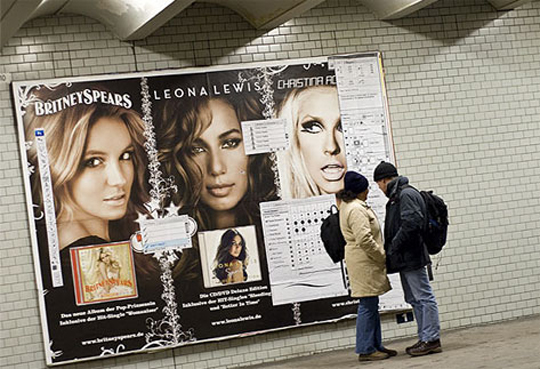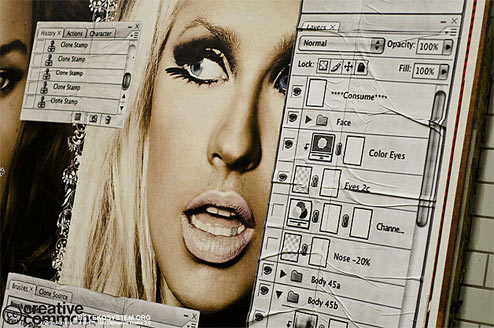SpaceCollective seems to have found a nice cushy spot where their members intersect between science and art. My, my, how I love it so.
Category Archives: Technology
Mikey is Listening
Since we at Harlot love the multimedia approach toward our articles as much as the text-based, I thought I might pass along something that might help you get that multi-modality a little bit easier. I know it can be difficult to get into hardware, when all you want to talk about is, say, the rhetoric of a dog park, but the technological aspects of things are important considerations.
Blue microphones has released a new mic recently, duly dubbed Mikey, which connects and allows you to record directly to your ipod. Super cool, no? Supposedly, it’s supposed to be some high quality hand held recording. I’d love it if Blue Mic would give samples of how the audio sounds, but, alas, it seems I’ll have to trust their ethos. Get this, though, it doesn’t require any software, which is always a selling point for me. (Really, you get enough hardware that requires software and you end up having more software on your computer than Steve Jobs.)
I carry my ipod around with me enough as it is and I wouldn’t be opposed to grabbing some cool audio out on the streets either. Unfortunately, though, it only works with iPod nano, 2G, 3G, 4G, 5G, and iPod Classic, so that leaves ipod touches and iphones out of the mix.
It is an $80 drop, but I do think it’s worth looking into. People create entire documentaries out of flip-cameras, I think someone could do just as well with little Mikey.
via Popgadget
Lessig in under 20
New an example of superb delivery skills? Heard of Lawrence Lessig, but unsure what his argument platform is? Searching for the modern day McLuhan? Check it:
Some days your friends make you proud

Who says kids today aren’t critical thinkers?
Days of Rage (part deux)
A few days ago I posted some off the cuff, rather glib remarks about President Bush’s response to having a shoe thrown at him, at the very end of which I note Bush’s acknowledgment of protest as distinctly different than, say, Nixon’s. Well, today I’m revisiting a really stellar article by Jodi Dean, Queen of I Cite, a blog that covers political theory the likes of Agamben, Foucault, Zizek, and so on, which brings up the topic in a more serious light; so I’d like to follow up on my post with a quote from her article, “Communicative Capitalism: Circulation and the Foreclosure of Politics,” from Digital Media and Democracy:
Even when the White House acknowledged the massive worldwide demonstrations of February 15, 2003, Bush simply reiterated the fact that a message was out there, circulating–the protestors had the right to express their opinions. He didn’t actually respond to their message. He didn’t treat the words and actions of the protestors as sending a message to him to which he was in some sense obligated to respond. Rather, he acknowledged that there existed views different from his own. There were his views and there were other views; all had the right to exist, to be expressed–but that in now way meant, or so Bush made it seem, that these views were involved with each other. So, despite the terabytes of commentary and information, there wasn’t exactly a debate over the war.
Dean goes on to make a persuasive case for the separation of a politics that is the simple circulation of content (websites, TV pundits, blogs, RSS feeds, listservs, and so on) and the politics of the institution (activities of lawmakers and bureaucrats). Today, she argues, these two politics operate almost entirely independent of each other. Sure, we’d like to think the circulation of content impacts the actual decision making . . . but it doesn’t. However, it does keep us busy.
I’ll end with one of her juicier claims:
The proliferation, distribution, acceleration, and intensification of communicative access and opportunity, far from enhancing democratic governance or resistance, results in precisely the opposite, the postpolitical formation of communicative capitalism.
There’s a distinct chance I’ll be posting on this over at Candid Candidacy if any of you are enticed by these ideas.
Video Essays!
Nothing I like more than a little analysis in a hard candy coating and, well, I feel like sharing.
Is He Bona Fide?
Is He Bona Fide? from Daniel Anderson on Vimeo.
“This video essay explores the theme of sincerity in the film O Brother, Where Art Thou?. The essay is composed in video form, using clips from the film as quotations and layering analysis over the clips through narration.”
Remix Culture II
Remix Culture II from Ricardo on Vimeo.
“My second mashup for the
Total Recut Video Remix Challenge 2008
“What is Remix Culture?”Here’s a list of all the entries in the competition:
http://www.totalrecut.com/contest-videos.php”
Watchmen Video Essay/Review
Watchmen Video Essay/Review from Adam Schoales on Vimeo.
“Here we go kids, after hours of writing, editing, shooting, cutting, and recutting my review… err… video essay for “Watchmen” is complete.
I’m going to work on creating a more concise version thats more along the lines of an actual review, but this should whet your appetite.
(and yes, I’m reading from a teleprompter. you try doing a 20 minute review from memory and smoothly…)”
The World is Flat 3.0
This is more of a lecture, but still mighty thought provoking. I especially like starting at the 29:30 minute mark when Thomas Friedman says that being able to use “imaginative thinking” and connecting dots, in the way liberal arts does, is essential. Then again, I’m a bit biased.
Bringing liberal arts into the equation is more important than ever, because we’re in a world now where imagination and mashups–the ability to mash things together through really imaginative, I think, thinking–is going to be such a huge advantage. . . I think inspiration, innovation comes from having two or more specialties and applying the framework of one specialty to the framework of another. And so, it is great, it is critical, it is essential. We have people who are experts at dots, but we also need, as individuals and collectives, to be encouraging the connecting of those dots and the mashing of them together.
Blogging with Arianna Huffington
Arianna Huffington talked about blogging about a month ago on The Jon Stewart Show. Of all the different explanations and discussions concerning blogging, I think I like her explanation best. She makes several comments I appreciate, including:
The difference about blogging is that it’s — as we say . . . first thought, best thought. Like, don’t over think it, don’t overwrite it . . . it’s a first draft of history.
or
Blogging is not about perfectionism. Blogging is about intimacy, immediacy, transparency, and sharing your thoughts the way you share it with a friend.
So, friends, I come to you now to bring up the conundrum of writing a book on blogging. Hmm, I say. I think the way she explains it is correct — blogging seems to be a “first draft of history” — typos and all. I can’t help but wonder about the marketing of this. I mean, bloggers would seem to be the ones truly curious about this book, but instead of releasing it as a pdf book, they chose to publish it on real paper. I have to wonder if they’re really reaching their audience.
BUT! I have a copy of Creative Nonfiction‘s “The Best Creative Nonfiction, Volume 1” which includes some choice blog posts. (I mean, they recently published “The Best Creative Nonfiction, Volume 2” that does the same thing.) If we’re now publishing the first draft of history (which is important, I’m not saying it’s not), then what happens to the 2nd and 3rd and 4th draft of history?
I suppose I’d like to see these posts retold later, you know? I’d like to see how the 2nd and 3rd drafts come out in comparison to the first. There’s no need to get rid of either–they both have validity, but I just want to see how they change. Obviously, typos would improve, but would reveal something about how we approach different audiences (ie from the internet readers to the book readers)? Would we change what we think? I don’t know, but I am curious to know.
Busting Ads with Photoshop . . .
Perhaps some of you will remember a post I did in December about the Pop-Down Project, a street art campaign that aimed to reorient our perception of everyday advertising. By sticking red click-it boxes resembling those in internet pop-up ads in the corner of street advertisements, the campaign asked its audience to consider a city experience that was free of ad-clutter. Of course, the campaign’s assumptions say loads about how we perceive our environment in an internet age and how we understand our ability to control what enters our visual field.
A related adbust has just, ahem, popped up in Berlin. A subway there got re-photoshopped — interfaced, if you will:

Once again we have a reframing of how we perceive images at street level by framing the picture in an interface.

This particular subversive act positions its viewer as active — in giving the viewer the illusion of control, it says, “go ahead, mash and mix it up. Interact with your everyday images in a more engaged way, just like you do with your images on your computer.” The tools to powerfully manipulate images towards persuasive purposes are being increasingly democratized. Protest tactics are changing as a result.
Chris Higgs, a blogging prophet, claimed at one point that our generation is and will be defined by its ability and penchant for Remix & Mashup. The writing is on the wall . . .
visualizing communication
If understanding the medium through which communication happens is an essential part of any successful rhetorical analysis, then the video below might provoke a few thoughts about rhetoric in a digitally connected age. GPS equipment is used in part to track the movement of telephone calls, fiber optic lines, taxis and airplanes:
If you find this interesting, head to Flowing Data to see other projects, like the growth of Wal-Mart since 1962.
Pop-up Protesting . . .
Check out this recent street-art activist campaign, The Pop-Down Project. As a response to the ever-increasing ad-creep that clutters our landscape and mentalscape, the project seeks to “symbolically restore” a user’s power to control their visual environment by shifting the context for how advertisements are viewed. In creating a false empowerment by offering the option for the ad to disappear, perhaps passer-byers will come to question the legitimacy of that ad occupying their field of vision.

It’s a fascinating case of internet literacy taking tangible and functional form at street level. Taken more wholistically, it’s interesting to note that the campaign seeks to wed the democratic spirit that is typically touted in street-art with the networking dynamics of Web 2.0 culture. The Pop-down project has blogspot site, a facebook page, and a slideshow on Picasa where people who have download the sticker from the site (shown below) can upload their finished product. I’d be curious to hear what you all think about the rhetorical maneuver being made here.

This campaign also brings to mind another anti-advertising street-art project, done by Graffiti Research Lab (who also has a strong web presence). Check out the video below, which seeks to collude street advertising with graffiti:
